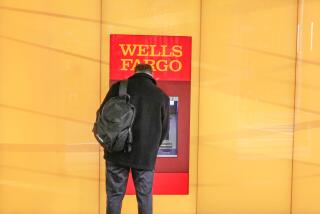67% of Minority Loans Rejected by Wells Fargo : Mortgages: So far, the bank has the highest rate of rejection for minority applicants for home loans among major institutions in 1991.
Wells Fargo Bank disclosed that it rejected more than two-thirds of minority applicants for home loans in 1991, the highest denial rate made public by a major bank so far, but added that the difference in rejection rates for ethnic groups narrowed last year.
The San Francisco-based bank reported that it rejected 67.5% of minority applicants for home mortgages in 1991, compared to 55% of white applicants for home loans. The bank, citing strict guidelines set by the buyers of mortgages as well as the soft economy, overall rejected 58% of all applicants in 1991, up sharply from 35% in 1990.
The results come as several other major banks nationwide released data that they claimed showed improvement in minority lending from 1990, although blacks and Latinos continued to be turned down more frequently for home loans than whites.
Executives at five of the nation’s 10 largest banks that revealed their minority lending records for 1991 said there’s considerable room for improvement.
“In a nutshell, we are not happy with the level of activity that Wells Fargo has in minority communities,” James Ketcham, a senior vice president of Wells Fargo’s mortgage division, told the Associated Press on Wednesday.
Nonetheless, Wells Fargo in a fact sheet argued that its rejection rate can be misleading. The bank argued that commercial banks are at a disadvantage to thrifts and mortgage bankers in making loans to low-income and minority customers because those institutions enjoy more lenient regulations on real estate loans. It added that thrifts, which statistics show are more active in low-income and minority areas, often have a large amount of business referred to them by mortgage brokers in those areas.
Bankers nationwide have been offering several reasons for the continued high denial rate for minority loan applications. They included: poor credit history and a high percentage of debt compared to income; increased demand for home refinancings, which are refused more frequently than general home loan applications, and the effects of the recession and tighter credit policies to clamp down on bad loans.
Here are the 1991 rejection rates of people who applied for home loans as reported by four major banks:
* Chemical Bank, New York: Rejected 55.6% minority applicants versus 36.5% of white applicants.
* NationsBank, Charlotte, N.C.: Rejected 33.7% of borrowers in predominantly minority communities, versus 18.6% in predominantly white communities.
* Chase Manhattan Bank, New York: Rejected 23% minority versus 7% white.
* Banc One, Texas: Rejected 40% minority versus 19% white. The Texas bank’s parent company, Banc One Corp. of Columbus, Ohio, doesn’t total minority lending statistics for its 57 banks. The Texas bank was selected as a general example of the banking group’s lending.
More to Read
Inside the business of entertainment
The Wide Shot brings you news, analysis and insights on everything from streaming wars to production — and what it all means for the future.
You may occasionally receive promotional content from the Los Angeles Times.










